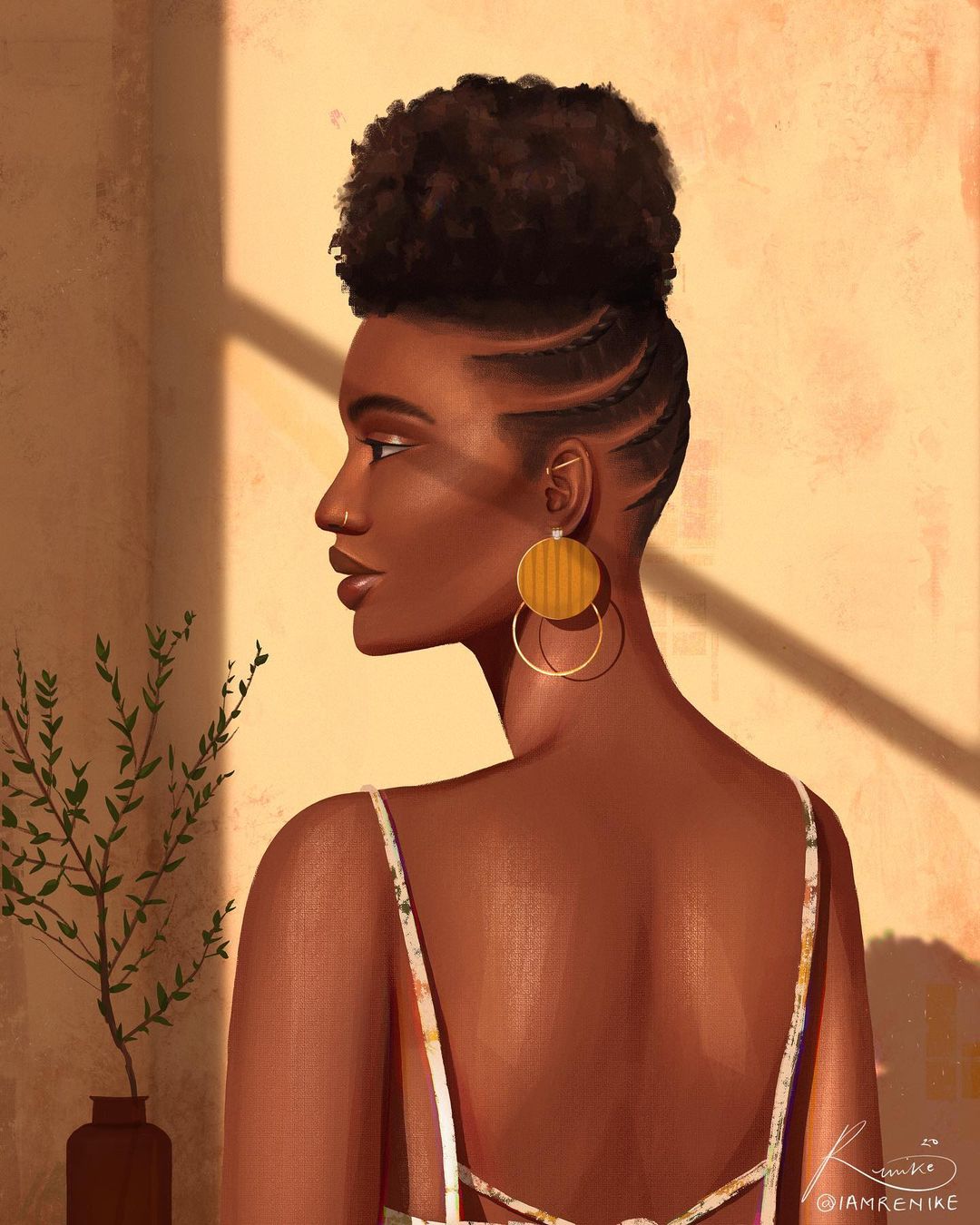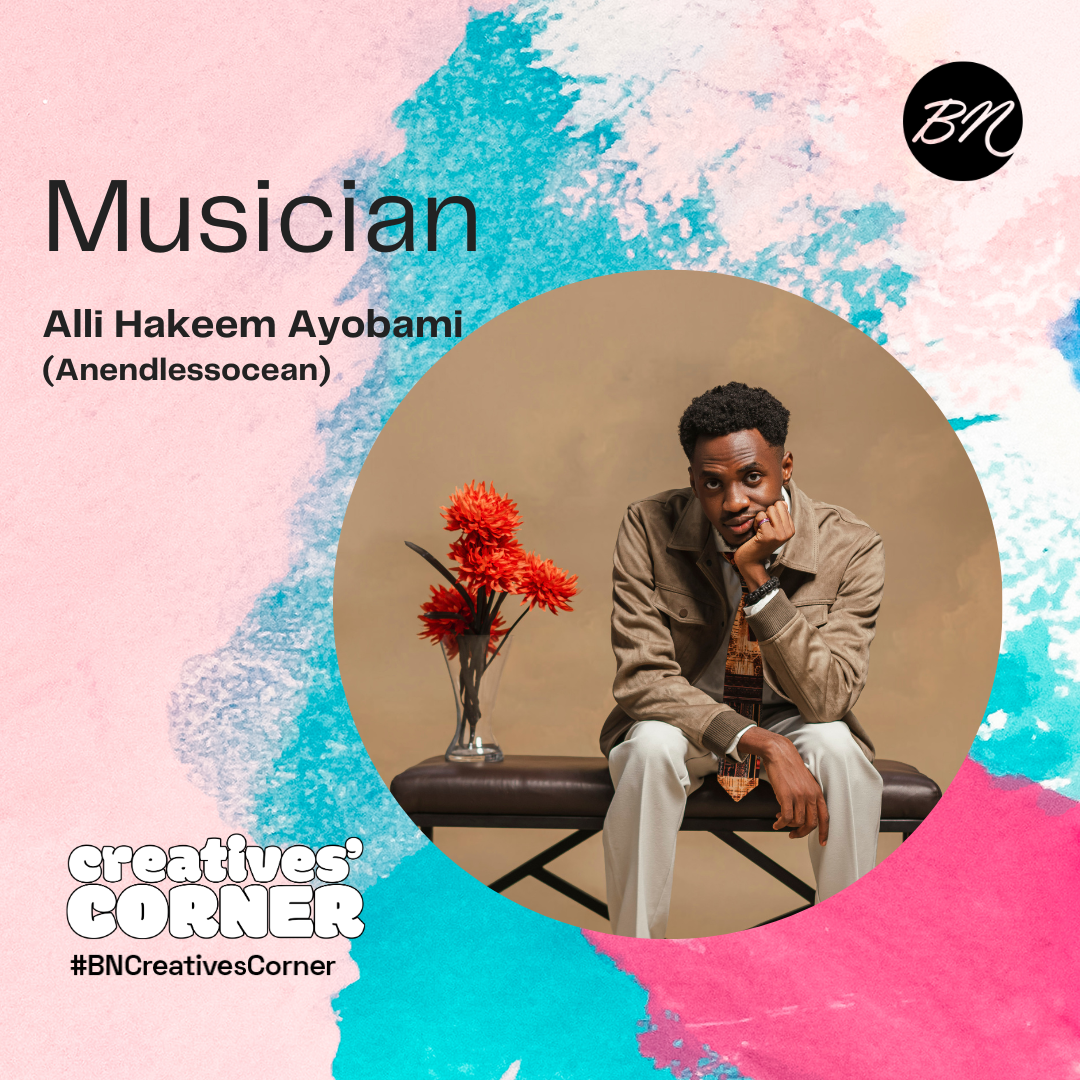Features
#BNCreativesCorner: Renike’s Artworks Spotlight the “Spice of the World”
 Renike’s works of art preach one thing: freedom. Whether they have their hair flying, or they are dancing on their toes, hanging in midair, wearing bold earrings, or painted in vibrant colours, the women in Renike’s artworks are black, stunning, valiant, unconforming, and free.
Renike’s works of art preach one thing: freedom. Whether they have their hair flying, or they are dancing on their toes, hanging in midair, wearing bold earrings, or painted in vibrant colours, the women in Renike’s artworks are black, stunning, valiant, unconforming, and free.
Popularly known as Renike, Morenike Olusanya is a visual artist and illustrator like no other. Her artworks explore the intricacies of being a woman living in a world where many women are relegated, and encourage them to embrace freedom. And this is deliberate. “Women are the spice of the world,” she laughs.
They inspire me. I’m also a woman and I can relate more with my experiences and the experiences of other women, than men or other sexes.“
In a world filled with so much turbulence and chaos, Renike wants her artwork to highlight comfort, positivity, growth and progress.
I want my artworks to help black women feel at peace and comfortable with themselves. I create them based on my experiences and things I see around the world that women experience. At the same time, not all my artworks are intended to communicate a message. Sometimes, it’s just me creating and enjoying the process.

Renike, like every other creative, started drawing at a young age – as far back as she can remember. Art was simply a way of expressing and communicating thoughts, ideas and feelings. You’ve probably heard a million and one artists say this. But with Renike, it is different. It wasn’t just something she did randomly – dipping brushes in watercolours like it didn’t matter, she had the skill, the brain, and the talent. All check.
I kind of always knew I was talented in the art since I was a teenager because I found myself more skilled than my peers. But I never really paid attention to it until someone offered to pay for it, that was when it dawned on me that I could actually make some money out of it.
_
Art wasn’t something Renike saw herself doing full-time, “but look at me now,” she laughs again. 5 years ago, she started drawing professionally but in 2020, she decided to go full-time. At first, she was terrified of her decision to become a full time artist but there was a bigger fear, one that trumped starting a brand: “I was more terrified of my physical and mental health deteriorating.”

See, working and living in Lagos will humble you; many people can testify to this. If you are a 9-5er and you live far away from work, you will understand the wahala involved in hopping from one danfo to another, and the toll it takes on your physical and mental health.
The stress of working a 9-5 in Lagos was something I knew I didn’t want to do. It’s depressing, especially when you live far away from work. I worked a 9-5 for about 3 years before I decided I couldn’t do it anymore. That was the major push. I was terrified of my decision to become a full time artist, but was more terrified of my physical and mental health deteriorating while working a 9-5 in Lagos. Don’t get me wrong, 9-5s are great when the environment is conducive and the working conditions make sense. I may even go back to doing one, but most likely not in Nigeria.
While I was working a 9-5 as a graphic designer, I was also freelancing as a visual artist and illustrator. It was my side gig. So I knew I would be able to make money from it, but I wasn’t sure I’d make enough money to sort out myself and other important responsibilities. But I decided to just do it and see how it goes.
When she decided to turn her side gig into her main gig, she didn’t know just how big she was about to become. Visual art wasn’t an uncharted territory for her, but leaving your 9-5 to start a business on your own is like diving into waters whose depth you are not sure of. Even if you can swim, there’s a nagging little “what if” voice telling you to stick with the safer option. But what do they say about people who believe in themselves? “It’s been over a year now and it’s been such an amazing journey. I don’t regret it one bit,” she says.

Renike has done well for herself. Recently, she talked about her art in a Vogue feature. It doesn’t end there, being an artist in Nigeria meets her financial needs, and this, many creatives would agree, is huge.
I sell prints of my traditional artworks to people all over the world. People also reach out to me to commission custom pieces for themselves and their businesses.
I’m grateful that my profession allows me to work with people all over the world, from anywhere in the world. Reception and patronage has been good, thanks to social media. I’m thinking of ways to make it better, lol. Money must be made. I’ve not received a lot of pushback or criticism from my audience, so I also guess that’s a good thing. There have been a few suggestions from them that I have scaled and noted and I’m grateful for that.

Renike’s journey, so far, may (look like it) has been filled with roses, still, there are tiny little thorns sticking off its stems. As a freelancer, there
have been setbacks that I and other freelancers (in any field) experience. Setbacks such as expensive internet, unstable electricity, payment wahala (as most of my clients are outside Nigeria), and Nigeria has made it ridiculously difficult to receive payment from international parties.
Many creatives would agree that ideas have wings, and, see, they do not hesitate to make use of them. One minute, your brain is brimming with all those grand ideas and the next minute, poof, into the wind goes that beautiful work of creation that you imagined would wow the world. Renike looks like she has found a way to pin down her ideas.
I write down my ideas all the time. I also have a mood board or boards/folders/albums where I save images that inspire me. When I create, it’s on ideas that I’ve had that have matured. “Matured” in the sense that I now have enough “ginger” to want to bring it to life after daydreaming about it for a while. It’s not always like this, by the way. Sometimes, I get inspired and have to execute immediately. I cherish moments like this because you get so inspired, it takes over your entire mind and body and you won’t rest till you draw the hell out of it.
I usually start with a sketch, then I start to use colours till I feel like it looks good enough to be termed “finished.” Depending on what I’m painting and the enthusiasm that accompanies it, painting usually takes from 4-6 hours, to a couple of days.
Most of my artworks are digitally painted. I practice traditionally from time to time with charcoal, watercolour and acrylics, but I’m currently not open to commercialising the originals or being commissioned to paint traditionally.
When I get less motivated to work, I do other things that I like. These things include watching movies/shows/youtube videos, playing games, going out with friends just to hang out or for exhibitions, engaging in conversations on social media, looking at art from other artists that I admire, and so on. It’s very normal to be uninterested or unmotivated sometimes, but I find that when I focus on other things, it always pulls me back to creating.
Creating art, for many Nigerians, is hard. Ah. How do you remain creatives when a tipper driver is repeatedly pressing his truck horn right outside your window, your neighbour’s generator is doing gree-gree-gree close to your bedroom, or you are spending 5 hours in Lagos traffic? More than ever, creatives need to work together to create an environment where creativity can blossom and be sustained.
I wouldn’t advise creatives to look to grow and sustain creativity in this part of the world because we are behind on so many things. I’d actually encourage them to expose themselves to other parts of the world, by travelling and working with people from outside Africa. International gigs should be their focus because that’s where it’s at. Maybe in the future, when things are more developed, especially in the art industry, we can talk about how to grow and sustain creativity.
Ouch.

If you are a creative trying to make a name for yourself, or find your place in the creative industry, Renike has something for you.
Don’t stop practicing and being open to learning and exchanging knowledge. I always say that the moment you start to feel like you know it all usually signifies the end of your growth. Remain curious and always put out your work because you don’t know who’s out there watching.
Finding your place in the creative industry is a personal journey. Depends on your field or area of specialisation and so many other things that are specific to you and what you vibe with. For me, it happened organically. I was just always consistent with painting and putting out work and from there, I sort of found my place with my community and target audience.
So I’d say they should be consistent and should put their work out there. Follow artists that inspire you on social media. Start conversations, establish connections with your fellow artists and things will fall into place with time.

Art may have, to a large extent, fetched Renike popularity and money, but for her, the best part of being a creative is being able “to create whatever I like, whenever I like.”
And this is golden.






















